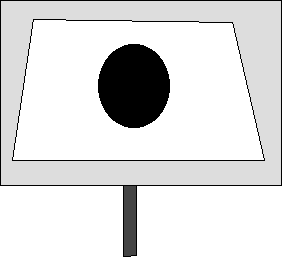Examples of ellipse as conic section
-
Take a vertical ray and another ray with the same endpoint and forming a 45 degree angle with the vertical ray. Revolve the second ray about the vertical ray to generate a cone. One unit from the endpoint of the ray, pass a plane through the axis at an angle of 30 degrees to the axis. (That is, the smallest angle the axis makes to the plane is 30 degrees.) The intersection of this plane with the cone is an ellipse.

-
In the above example, if the plane is perpendicular to the axis of the cone, the result is a circle, a special case of an ellipse.

- Take the cone above and rotate it until its axis forms an angle of 30
degrees with the line that it lay on before rotation. Intersect the rotated
cone with a horizontal plane. The resulting ellipse is the same as the
one in the first example.

- If a slide projector projects a picture of a circle onto a screen, the
projection of that circle forms a cone and the screen is a plane cutting
the cone. If the entire image of the circle is on the screen, the image
will be an ellipse.

- Similarly, if a flashlight shines on a ball in such a way that the entire
shadow is on the flat surface under the ball, then the shadow is elliptical.

-
If a circle is viewed from any perspective other than straight-on, it appears to be an ellipse. The circle is the intersection of a plane with a cone whose axis goes through the viewer's eye and the middle of the circle.












